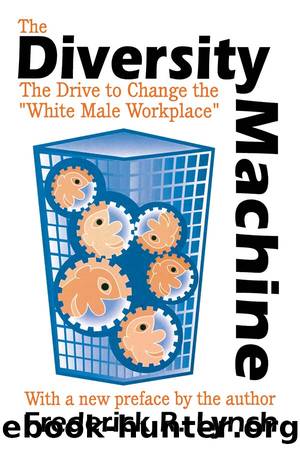The Diversity Machine by Frederick R. Lynch

Author:Frederick R. Lynch [Lynch, Frederick R.]
Language: eng
Format: epub
ISBN: 9780765807311
Barnesnoble:
Publisher: Transaction Publishers
Published: 2001-09-30T00:00:00+00:00
The Costs of Workforce Diversity
Just as the alleged benefits of workforce diversity programs are difficult to assess, especially with quantitative measures, so are the costs. In 1995, U.S. employers budgeted $52.2 billion for formal employee training. Diversity training was one of the hotter topics provided by 53 percent of firms with over 100 persons.42
As we have seen, however, most diversity training (when such training really is diversity training and not more legal updating on affirmative action rules) is of the one-shot variety and is not an especially big ticket item. It is, however, like paying insurance. A bit of such diversity training can help ward off expensive lawsuits, settlements, and adverse regulatory actions. Indeed tax-cutting proponent Steve Frates, executive director of the San Diego Taxpayersâ Association, told me how he justifies that cityâs massive million-dollar diversity training program: âIf it stops one sexual harassment suit, its worth the investment.â (On the other hand, such defensive training could backfire. Based on a court case involving Californiaâs Luckyâs Supermarkets, seemingly racist or sexist statements made in diversity training sessions can be subpoenaed as evidence in subsequent discrimination cases.)
Permitting the formation of various cultural support groups is likely a negligible expenseâif these activities are conducted after hours. (Executive listening time may be more costly.) On the other hand, the creation of full-time diversity managers in larger organizations suggests that the tasks are becoming too time-consuming to be added on to other responsibilities.
The most potentially expensive workforce diversity policy is the one urged most fervently by its most radical proponents: rewarding mangers for proportional promotion and retention of women and minorities. A recent Wall Street Journal assessment found that only a handful of corporations do this; it is not yet a trend, largely because âmeasuring the bottom-line benefits of diversity has been especially difficult for many U.S. corporations.â43 Insofar as such practices mimic the costs of affirmative action hiring, there is a general quantitative benchmark: Peter Brimelow and Leslie Spencers Forbes magazine study. The direct and indirect costs of the visible part of the âquota iceberg,â as they describe the programs, is approximately $113 to $116 billion. The below-the-waterline, hidden costs of bad hiring and misallocation of financial resources they estimate at $236 billionâand that does not include the likely huge expense of âeffect on morale.â Affirmative action preferences, they conservatively conclude, have a total cost of more than 4 percent of the gross national product.44 Should the full range of spreading workforce diversity programs equal the costs of affirmative action, then the drag on the GNP may approach 10 percentâa development to delight the nations international competitors.
As with affirmative action, academic researchersâand many independent onesâsense that diversity management is a subject best not closely studied. A university professor who threw cold water on such policies, especially if he or she were in the liberal arts or softer social sciences, would likely be subjected to isolation, if not direct retribution. A researcher close to the heart of the diversity machine let the cat out of the bag: âPeople are afraid to find out that these programs donât work.
Download
This site does not store any files on its server. We only index and link to content provided by other sites. Please contact the content providers to delete copyright contents if any and email us, we'll remove relevant links or contents immediately.
| Conflict Resolution & Mediation | Human Resources & Personnel Management |
| Knowledge Capital | Outsourcing |
Bullshit Jobs by David Graeber(4141)
Radical Candor by Kim Scott(2692)
I Am Right, You Are Wrong by Edward De Bono(2428)
23:27 by H. L. Roberts(2223)
Nomadland by Jessica Bruder(2037)
Average Is Over by Tyler Cowen(1825)
The Conflict Resolution Phrase Book by Barbara Mitchell & Cornelia Gamlem(1754)
Out of Our Minds: Learning to Be Creative by Ken Robinson(1720)
High-Impact Interview Questions by Victoria A. Hoevemeyer(1673)
Who Moved My Cheese?: An Amazing Way to Deal With Change in Your Work and in Your Life by Johnson Spencer(1626)
The Ideal Team Player by Patrick M. Lencioni(1621)
An Everyone Culture: Becoming a Deliberately Developmental Organization by Robert Kegan & Lisa Laskow Lahey(1620)
The Asshole Survival Guide by Robert I. Sutton(1579)
Automatic Society by Bernard Stiegler(1532)
Unleashed by Anne Morriss & Frances Frei(1515)
Who by Street Randy & Smart Geoff(1486)
42 Rules of Employee Engagement by Susan Stamm(1451)
96 Great Interview Questions to Ask Before You Hire by Paul Falcone(1435)
Fish! by Stephen C. Lundin(1377)
